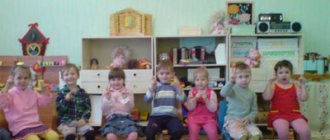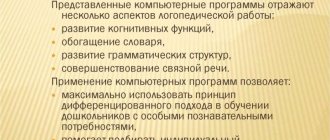Article:
RELATIONSHIP IN THE WORK OF A Speech Pathologist WITH MEDICAL STAFF
1. Work with medical records of children entering a preschool educational institution to collect anamnesis for the purpose of early diagnosis and selection of children into groups with speech disorders.
2. Preparation and organization on the basis of the preschool educational institution of the district PMPK for the selection of children for the speech group.
3. Preparation of documents and organization of medical examination of children of the speech group by the following doctors: pediatrician, neurologist, otolaryngologist, surgeon, ophthalmologist.
4. Timely referral for medical examination of children with severe speech disorders (dysarthria, alalia, stuttering) in order to assist in the work of a speech therapist through drug treatment and physiotherapeutic procedures.
RELATIONSHIP IN THE WORK OF A Speech Pathologist WITH A TEACHER-PSYCHOLOGIST
1. Organization of psycho-gymnastics classes.
2. Reducing emotional stress through different types of activities.
3. Development of mental processes: attention, memory, perception, logical
thinking through various forms of activities.
4.Development of visual gnosis.
5.Expand children’s knowledge through familiarization with the environment
reality.
6.Develop the ability to classify, group, and generalize objects.
RELATIONSHIP IN THE WORK OF A Speech Pathologist WITH AN ART TEACHER
1. Practice knowledge of primary colors and their shades in classes with children.
2.Develop orientation in space through different types of activities.
3.Development of visual perception.
4.Development of fine motor skills of the fingers using lexical topics (with
taking into account the long-term plan of the speech therapy group).
RELATIONSHIP IN THE WORK OF A Speech Pathologist WITH A PHYSICAL INSTRUCTOR
1.Development of general motor skills through games and exercises in the classroom.
2.Form correct speech breathing (duration of exhalation, differentiation of oral and nasal breathing).
3. Conduct relaxation exercises (relaxation) to relieve muscle tension with elements of psycho-gymnastics.
4.Development of coordination of movements, orientation in space in accordance with the verbal instructions of the teacher:
a/ Corrective tasks for the development of perception, attention, memory and other higher functions;
c/Form the ability to focus one’s attention on actions - verbal instructions from the teacher.
Remember the sequence of two or more tasks, as well as remember
verbal instructions from the teacher with gradual complication (imitation of movement
animals, birds, etc.)
RELATIONSHIP IN THE WORK OF A Speech Pathologist WITH A MUSIC DIRECTOR
TASKS OF LOGORHYTHMIC INFLUENCE:
- Preparatory stage –
1. Development of musical, pitch, timbre, dynamic
hearing; sense of rhythm; auditory attention; spatial organization
movements; facial expressions; general and fine motor skills, speech motor skills for
formation of the articulatory structure of sounds.
— Stage of formation of primary pronunciation skills –
staging, automation, differentiation of sounds.
1. Automation of sounds in chants.
2.Continue to develop non-speech functions.
3.Improve speech motor skills (switchability, coordination; accuracy of movements).
4.Development of pitch and dynamic hearing; phonemic perception.
5. Developing the ability to restore connections between sound and its musical image
– Stage of formation of communication skills –
1. Consolidation of motor skills through various techniques in class.
2.Improve musical ear; phonemic awareness; singing range of voice.
3. To develop the ability to correctly use the sounds of the native language in various forms and types of speech in music classes; as well as in all communication situations.
RELATIONSHIP IN THE WORK OF Speech Pathologist AND TEACHER
A big problem in the implementation of the main directions of meaningful work with children of senior preschool age with SLD level III is the implementation of specific interaction between the teacher and the speech therapist, ensuring the unity of their requirements when fulfilling the main tasks of the program training. Without this relationship, it is impossible to achieve the necessary correctional focus of the educational process and build an “individual educational route”, overcome speech insufficiency and difficulties in social adaptation of children.
The main tasks of the joint correctional work of a speech therapist and teacher are:
-Practical acquisition of lexical and grammatical means of the language.
-Formation of correct pronunciation.
-Preparation for teaching literacy, mastering the elements of literacy.
-Development of coherent speech skills.
At the same time, the functions of the teacher and speech therapist should be quite clearly defined and delineated (Table 1).
Table 1.
Joint correctional activities of a speech therapist and a teacher.
| Teacher speech therapist | Educator |
| 1. Creating conditions for the manifestation of speech activity and imitation, overcoming speech negativism | 1.Creating an emotional environment well-being of children in the group. |
| 2. Examination of children’s speech, mental processes associated with speech, and motor skills. | 2. Examination of the general development of children, the state of their knowledge and skills according to the program of the previous age group. |
| 3. Filling out a speech card, studying the examination results and determining the level of speech development of the child. | 3. Filling out the examination protocol, studying its results for the purpose of long-term planning of correctional work. |
| 4. Discussion of survey results | 4. Compilation of psychological and pedagogical characteristics of the group as a whole. |
| 5.Development of children’s auditory attention and conscious speech perception. | 5. Education of general and speech behavior of children, including work on the development of auditory |
| 6.Development of visual, auditory, verbal memory. | 6. Expanding the horizons of children. |
| 7. Activation of vocabulary, formation of general concepts | 7. Clarification of the existing vocabulary of children, expansion of passive vocabulary, its activation through lexical and thematic cycles |
| 8. Teaching children the processes of analysis, synthesis, comparison of objects according to their components, characteristics, and actions. | 8. Development of children's ideas about time and space, shape, size and color of objects (sensory education). |
| 9. Development of mobility of the speech apparatus, speech breathing and, on this basis, work on correcting sound pronunciation. | 9. Development of general, fine and articulatory motor skills in children. |
| 10.Development of phonemic perception in children. | 10.Preparing children for the upcoming speech therapy session, including completing tasks and recommendations from the speech therapist. |
| 11. Teaching children the processes of sound-syllable analysis and synthesis of words, analysis of sentences. | 11. Consolidation of speech skills acquired by children in speech therapy classes. |
| 12. Development of perception of the rhythmic-syllable structure of a word. | 12.Development of children's memory by memorizing various types of speech material. |
| 13. Improving inflection and word formation skills. | 13. Consolidation of word formation skills in various games and exercises. |





